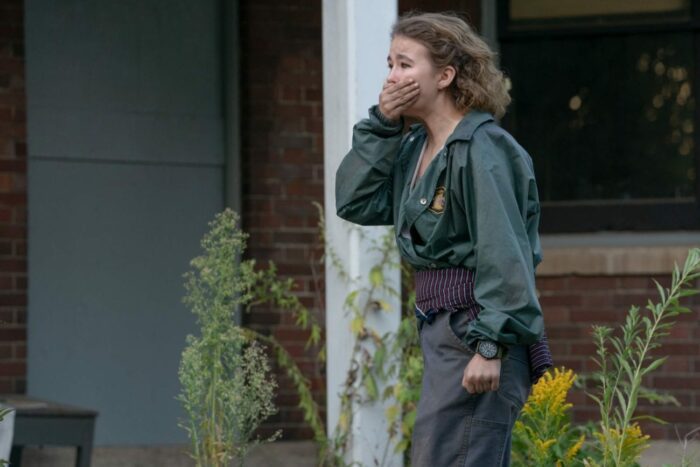Treading down the homemade sound-muffling sandy paths of eastern New York again for A Quiet Place Part II roused a chin-rubbing line of inquiry for this very writer. Now that we’re into a second film of this creature feature scenario, can John Krasinski’s movie still get away with holding back basic details? In 2018, not entirely knowing what the threat to the Abbott family was, was a large portion of the heady and suspenseful appeal that made A Quiet Place a tremendously vivid film and successful box office winner.
Three years later and tip-toeing in the trajectory of becoming a successful trilogy or even a franchise, do you, the eager audience, need to know more stuff about all things A Quiet Place, like where the monsters came from, why they’re here, or even something trivial like how, when, and where do they sleep? Is there a mental inquest going on of random light bulb questions like those that nag your perturbed logic? Like a Christopher Nolan film, do you need some authority figure or power player presence to come in, take over the movie for a little while, and drop more definitive exposition? Is it time for that and, more importantly, is it necessary?

The resounding answer across the board is no. The counterpoint would be to ask why ruin what stands as a distinctive strength. While A Quiet Place Part II ventures outside of its original single setting into the open world of its neighboring countryside, any omniscient truth is still rightfully guarded and methodically uncloaked at its own speed. Simply put, to know any more than our invested characters in harm’s way would take away the whole fascinating mystique that draws us with its purposeful and rapt silence.
Admittedly, those looking for a little background into the ongoing cataclysm get a whiff of that in the first ten or so minutes of A Quiet Place Part II. The writer-director calls his own number to return as Lee Abbott in flashback to “Day 1,” when the unnamed, sightless leviathans first arrive in his quaint hamlet while the town is enjoying little league baseball. It’s a harrowing sequence of chaos that slyly passes the sound-editing baton of POV hearing between Lee and his deaf daughter Regan (Millicent Simmonds) as their family narrowly escapes the introductory onslaught.

Fast-forward 474 days and this sequel takes over mere minutes after the culminating events of the first film. Through amplified feedback coming from Regan’s hearing aid that paralyzes the monsters’ primary sense and unravels their physical defenses, the Abbotts have miraculously found a means of fighting back. However in the ruins of this previous battle, Evelyn (Emily Blunt) and her children (Simmonds, Noah Jupe as Marcus, and the new infant) are now fatherless and homeless. They are forced to trek out to find resources and, hopefully, helpful survivors.
Thanks to the prior lead of their departed patriarch, the Abbotts have harnessed resilience and fortitude through this ordeal. They stay calm, breathe, and protect each other. The same cannot be said for other people. This is typified greatest in A Quiet Place Part II by Cillian Murphy’s distrustful and sullen Emmett. As an old friend of Lee’s, he is the nearest help Evelyn finds, but his own family has been lost and it has changed him. He’s unwilling to shelter the Abbotts long-term. Gutted and fatalistic, Emmett is quick to outline what other people have become by declaring they are “not the kind of people worth saving.”

This is where the inverse best person in the movie takes over. Driven to help beyond her handicap, Regan leaves her mother and siblings on her own to reach a nearby working radio station where she can broadcast her special frequency to all who can receive the signal. She does so with the bravery to honor her father’s efforts and promises because, unlike others, he would always push to do more. Sharing that trait is beyond special.
Folks, if you never saw the brilliance, moxie, and courage of Millicent Simmonds way back in Wonderstruck or previously in A Quiet Place, you will swell with endless admiration now. She is the outright hero of this whole movie (Murphy is a moderate second), a fact to downright enunciate (you’ll see), cheer, and love.

Through this treacherous course of travel, A Quiet Place Part II expands the threats and objectives. Sharp editing from Michael P. Shawver (Black Panther, Creed) shimmies thrillingly between two and sometimes three apexes of concurrent subplots, multiplying the well-concocted peril happening in each place. Production designer Jess Gonchor (Little Women, No Country for Old Men), a two-time Oscar nominee, created the intriguing indoor and outdoor obstacles laid before our characters. From a special effects standpoint, what was mostly unseen the first time around is now inescapable and given more observable detail and ferocity, thanks to ILM’s work supervised by Scott Farrar (World War Z) and coordinated by William V. Ross (Aquaman).
Patient and savvy in its pacing and capacity, all of these areas of gradual intensification feel like a fitting natural progression. Yet, it’s still a tempered one, as evident by those resounding “no” answers from earlier. More is offered without excess. Too often, cash-infused sequels to successful shoestring original movies get overindulgent in their intentions and magnitude. This movie’s budget grew from $17 million three years ago to $61 million now, and you would never know it other than the slightly expanded settings and extra bestial clashes.

Sure, A Quiet Place Part II chooses its spots to unfurl moments a little bigger or a little louder, but it hasn’t lost its core intimacy of sensory-based tension. It’s slowest and simplest moments remain the most affecting. Returning composer Marco Beltrami continues the Dolby ATMOS-rattling orchestral dread that quickens heart rates. If they wanted to, the special effects and the stunt departments could turn these characters into improbable action heroes for enlarged thrills and superhuman feats. They wouldn’t and they didn’t. Such would be out of line, and John Krasinski knows it.
Chiefly of all, Krasinski hasn’t lost the importance of emotionality. It could have been quite easy, and tempting, to create humans as evil as the monsters in order to inject extra social commentary, but that would take away from the aforementioned resilience we’re attracted to so strongly which beats this movie’s heart. The family dynamics forge the difference between stock archetypes we can earmark for their impending demise normally found in this genre and the true flesh-and-blood characters that viewers care to not see lose their literal flesh and blood. This is horror and feels, without a hint of torture porn or sadistic bloodlust in sight. What a visceral combination once again!



